A Concise Introduction to Jazz Clarinet Methods and Techniques for High School and College Students
Vashawn Arora | Arizona State University | Spring 2020
Introduction
For this project, I will create a concise, daily practice routine for Bb clarinet players interested in expanding their knowledge and application of jazz methods and clarinet techniques. My intended audience for this project includes myself, the clarinet studio at Arizona State University, and fellow clarinet colleagues and students around the world. Myself because I am looking for a more pedagogically concrete routine to teach different areas and components of jazz. The clarinet studio and other high school/collegiate clarinet students are my primary audience in creating this online database/foundation for musicians to follow a comprehensive routine and approach to jazz clarinet studies.
This project will focus on four main components: fundamentals, ear training/listening, transcription, and repertoire.
- Fundamentals are the basic foundation for clarinet technique and enable musicians to have a better understanding of the instrument and music theory. Clarinet fundamentals can include (but are not limited to): long tones, scales, arpeggios, thirds, articulation, melodic and rhythmic patterns/cells.
- Ear training/listening is an aural component of developmental recognition and application of music theory understanding. For our purposes, this will be essential in expanding our palette of available music.
- Transcription simply refers to reciting what you hear. For our purposes, transcription includes physical documentation and notation inherently coupled with listening and ear training. Working on this component will allow us to better digest music in our recognition of musical patterns (such as intervallic relationships, relative rhythmic durations, decisions of notating expressive markings, etc.)
- Repertoire is a list or set of music. For our purposes, this daily routine will add pieces to our repertoire list and create a framework for how to approach more pieces of jazz discography in the future.
Day 1
Listening: How to Play New Orleans Style Clarinet
This is an introduction to New Orleans traditional jazz playing by Dr. Michael White and Jazz at
Lincoln Center. Traditional Jazz, also known as Dixieland Jazz, is a genre based in the
1910s-1920s that is seen as a predecessor to the swing and big band era of jazz. This video
touches briefly on key concepts of style, articulation, melodic/rhythmic embellishment, and oral
cavity-based vibrato in a tune called Careless Love in concert F Major. While there are many
ways of historically approaching and studying jazz clarinet, beginning with traditional jazz
allows for gradual and parallel musical developments with chronological time periods.
Below is a lead sheet where you can follow along, play, and watch as Dr. White talks through his
approach. In addition, below is a backing track for the tune in F Major for you to play through
the melody and begin attaching some of Dr. White’s comments to your own playing. There will
be a four click countoff for this sixteen bar form.

Day 2
Fundamentals
With scales and other basic forms of clarinet technique comes an infinite amount of permutation and variation. Below is an exercise that presents a major scale and an arpeggiated variation. Understanding and practicing diatonic triadic units based on every scale degree is an effective technique that can translate to other areas of jazz clarinet studies. Set your metronome to quarter note equals 60 and play through this exercise. You can continue around the circle of fifths til you reach back at C major.
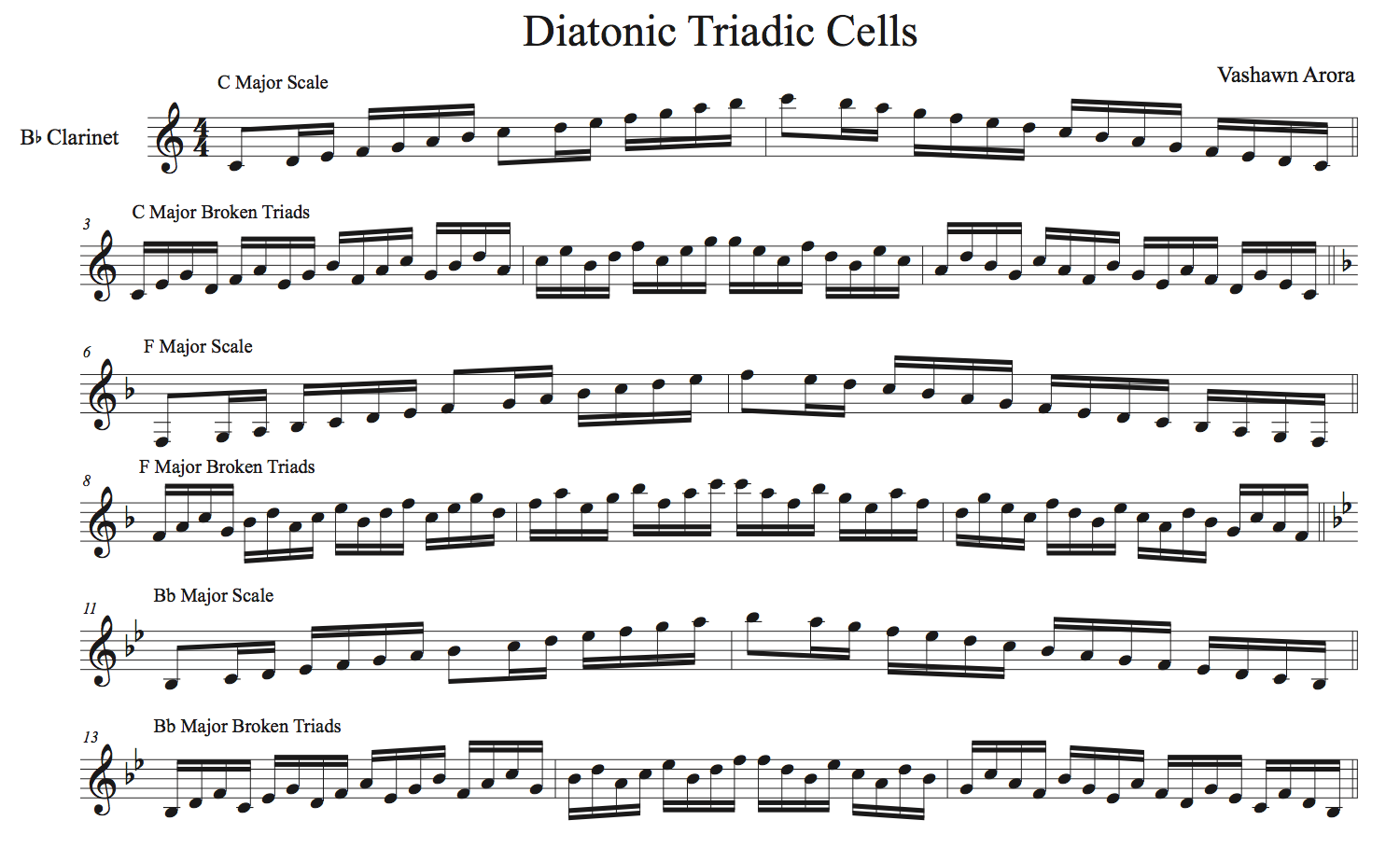
Day 3
Listening: Collective Improvisation in New Orleans Jazz
Here is another traditional jazz video by Dr. Michael White on collective improvisation. “Collective improvisation” is the overarching term that describes ensemble interplay in this style. Understanding the role of the clarinet as embellishment or obligato to the main melody is an important historical and stylistic characteristic to note. This video discusses concepts of voice leading and rhythmic variation within the obligato framework. Listen to the first few choruses and think about his approach. Below is a transcription to play along and embody such stylistic choices that make jazz clarinet an essential voice in a traditional jazz ensemble.
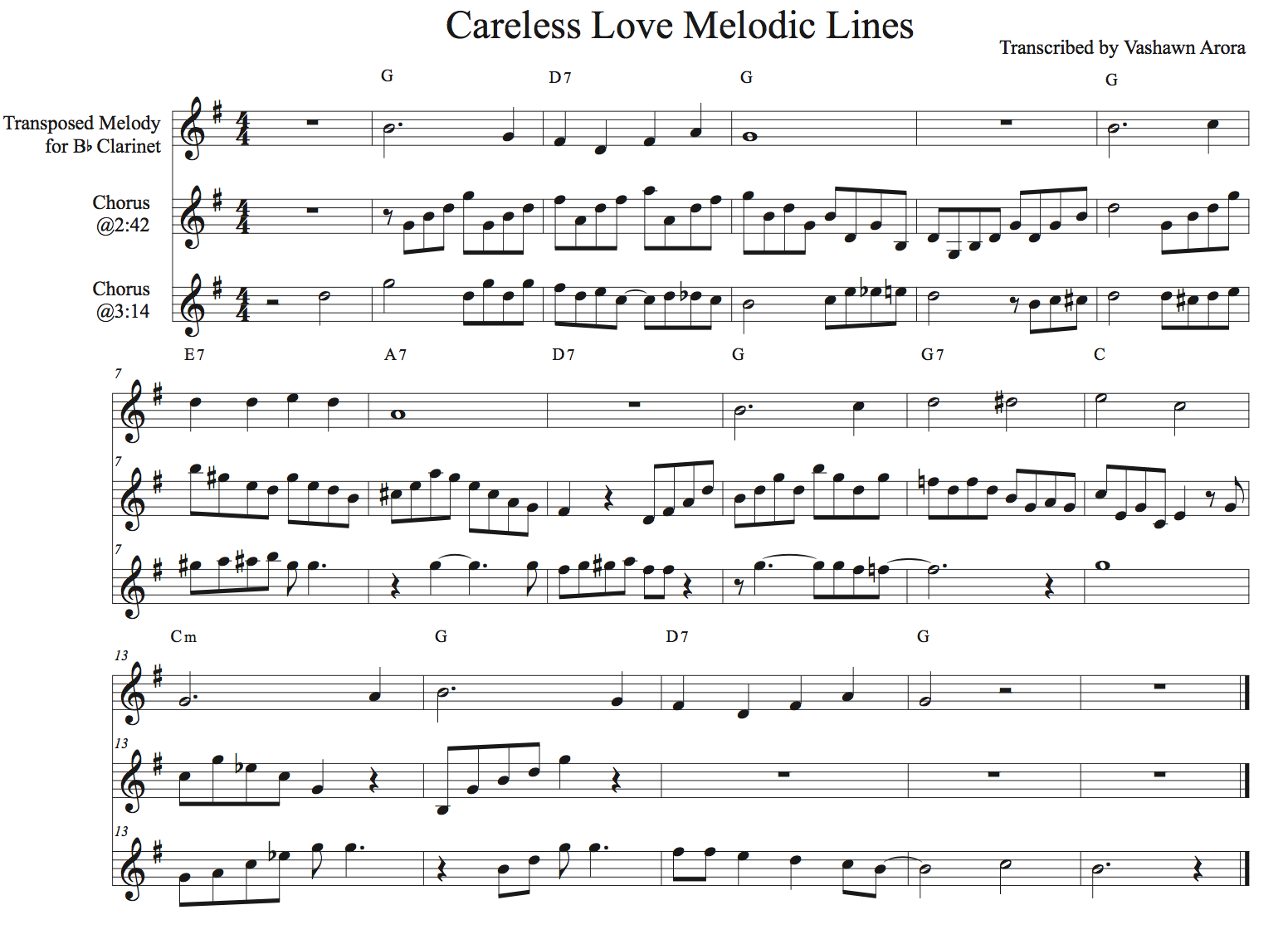
Transcription
Listen again to “Six Appeal” by Benny Goodman and his sextet. We are going to begin the transcription process today. Get out some staff paper and try to count the measures of 4/4 at the beginning. We are going to transcribe the clarinet melody for the four bar introduction and the first sixteen bars of the forms. Give yourself a great amount of writing space in each measure and don’t be afraid to erase. Feel free to use the speed adjustment on the youtube video if you need to slow it down. Of course, questions of how to transcribe arise. Here are two methods to try: 1) listen and sing the intro pickup with your voice and keep the quarter note pulse in your head, using your instrument to check pitches and durations. 2) listen to a bar and playback what you heard on your instrument, notate on paper after. Both are valuable approaches and get us thinking critically about how to efficiently comprehend what we’re hearing. Of course, questions of specificity arise in the transcription process. Should I include dynamics, articulation markings, very precise rhythmic durations, etc.? There is no right answer. Transcribe however much til you feel satisfied with your physical documentation. My transcription will be later where we will check the whole thing. This will give us many attempts to continually listen to each section.
Day 4
Transcription
Listen again to ‘Six Appeal” by Benny Goodman and his sextet. We are going to continue the transcription process. You should have a four bar introduction and sixteen bar form written out so far (ending @0:33). After is another sixteen bars for the guitar. You can transcribe this if you want or skip to @0:59 for when the clarinet comes back in with a pickup to the next section. Today, we’ll be transcribing the next 8 bars, rests for the vibraphone, and the clarinet solo for sixteen bars. Your transcription should end @1:55. Again, this should be a difficult process and make us think critically about how to physically document what we’re hearing. Below is the structure of the form so far.
Form of “Six Appeal” thus far:- 4 Bars, Intro
- 16 Bars, Clarinet
- 16 Bars, Guitar
- 8 Bars, Clarinet
- 8 Bars, Vibraphone
- 16 Bars, Clarinet Solo
- 16 Bars, Bass solo
Day 5
Listening and Repertoire
Let’s revisit the collective improvisation video from Day 3. Improvisation is an important component that requires musical flexibility and a solid understanding of music theory and harmony. After the choruses we looked at, Dr. Michael White takes his obligato playing further through adding more space and being more thoughtful about his entrances and exits. Listen through the next set of choruses @4:22 and notice the difference in rhythmic interplay between the instruments. Again, below is a transcription to play along and embody these concepts. In addition, you can revisit the backing track from Day 1 to play these melodic lines one your own and begin to add your own embellishment to the original melody.
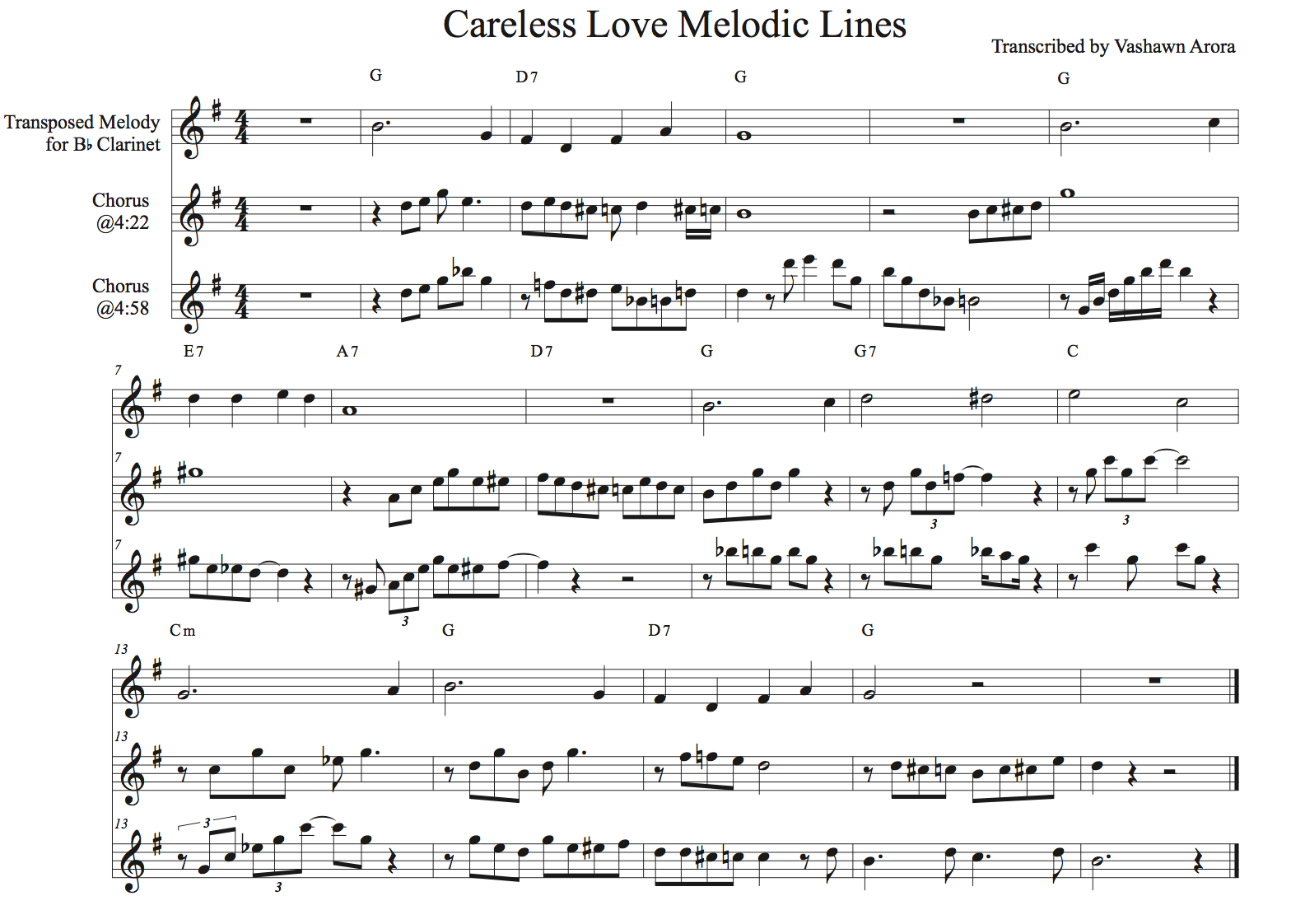
Day 6
Fundamentals
Blues scales are six note scales that are based off of the major/minor pentatonic scale with an
added note. These scales and patterns serve as an important foundation for improvisation.
Below is a set of blues scales you can practice. In addition,
here is a backing track for a 12 bar concert Bb blues.
You can take your first blues scale (in our C major) and play over the whole form.
12 bar blues are one of the most popular chord progressions used in many genres, including jazz.
The form of the 12 bar blues is very recognizable. The form is below. As I mentioned, the blues
scale is a great introduction into playing over the entire form.
Roman numerals:
I, I, I, I,
IV, IV, I, I,
V, V, I, I
Lead sheet in our transposed blues (from concert Bb):
C, C, C, C,
F, F, C, C,
G, G, C, C
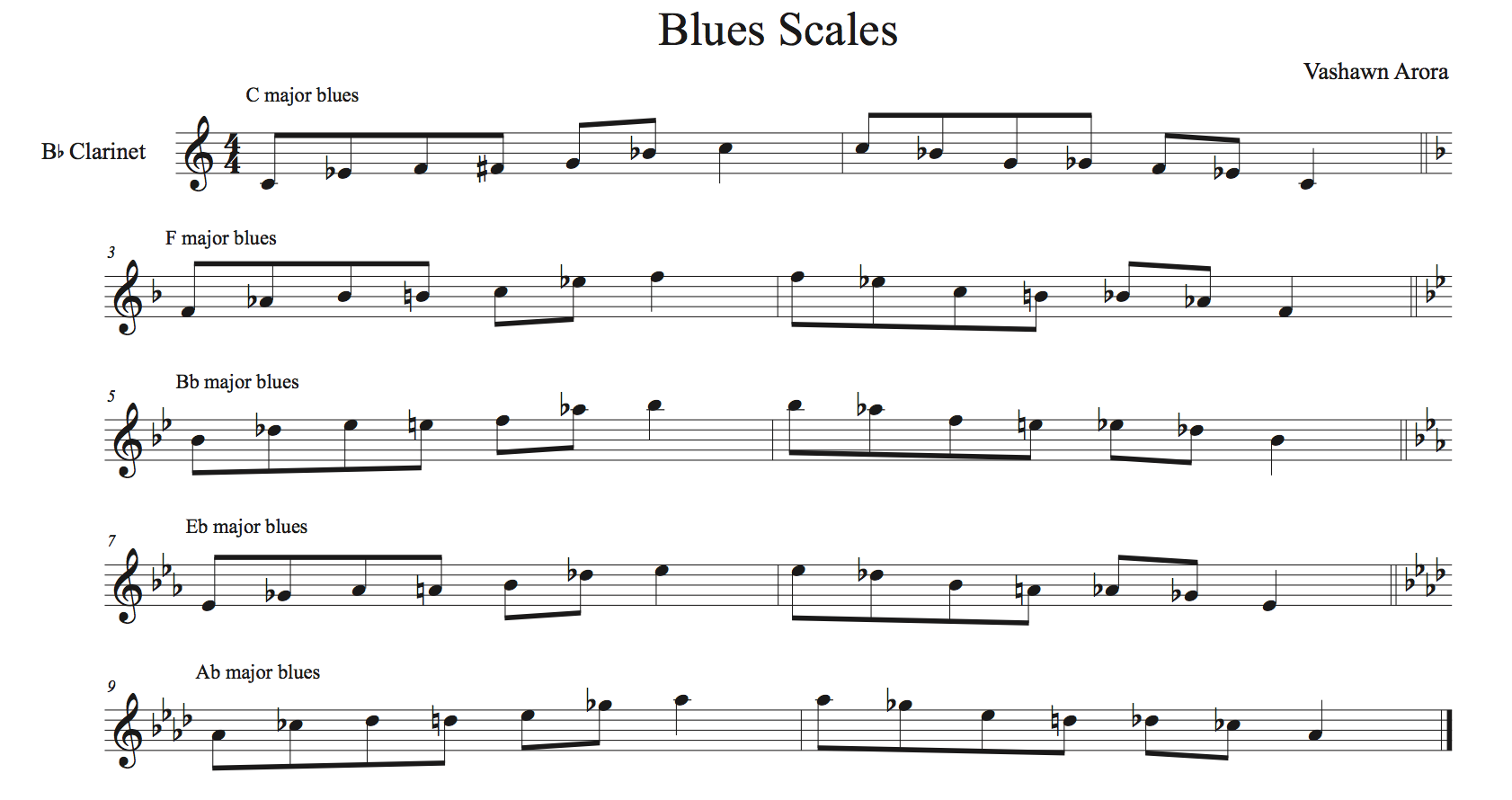
Transcription
Let’s continue our transcription of “Six Appeal”. We left off @1:55 with the bass solo for 16 bars. The clarinet has a pick up leading into the next section with the vibraphone. Here, we have 16 bars, 8 bars, and then 10 bars with the tag. And then we’re done! Below is the entire form:
Form of “Six Appeal” thus far- 4 Bars, Intro
- 16 Bars, Clarinet
- 16 Bars, Guitar
- 8 Bars, Clarinet
- 8 Bars, Vibraphone
- 16 Bars, Clarinet Solo
- 16 Bars, Bass solo
- 16 Bars, Clarinet and Vibraphone
- 8 Bars, Clarinet and Vibraphone
- 10 Bars including tag
Day 7
Ear Training/Listening
Chords are made up of chord tones. Chord tones are defining factors and can be used effectively to transition to the next chord, such as with voice leading. Below is the A section to rhythm changes, another widely used chord progression deriving from George Gershwin’s “I Got Rhythm”. This example shows two very important chord tones, the chordal thirds and sevenths, as the basis for the voice leading exercise. Follow through and see how a rough melodic contour sketch can be created and used for a solo. Below is a backing tracking of rhythm changes to play along. In addition, take a look back at the choruses from Dr. Michael White’s version of Careless Love and note any instance of a chordal third or seventh being used to transition or as an arriving point in the next chord.
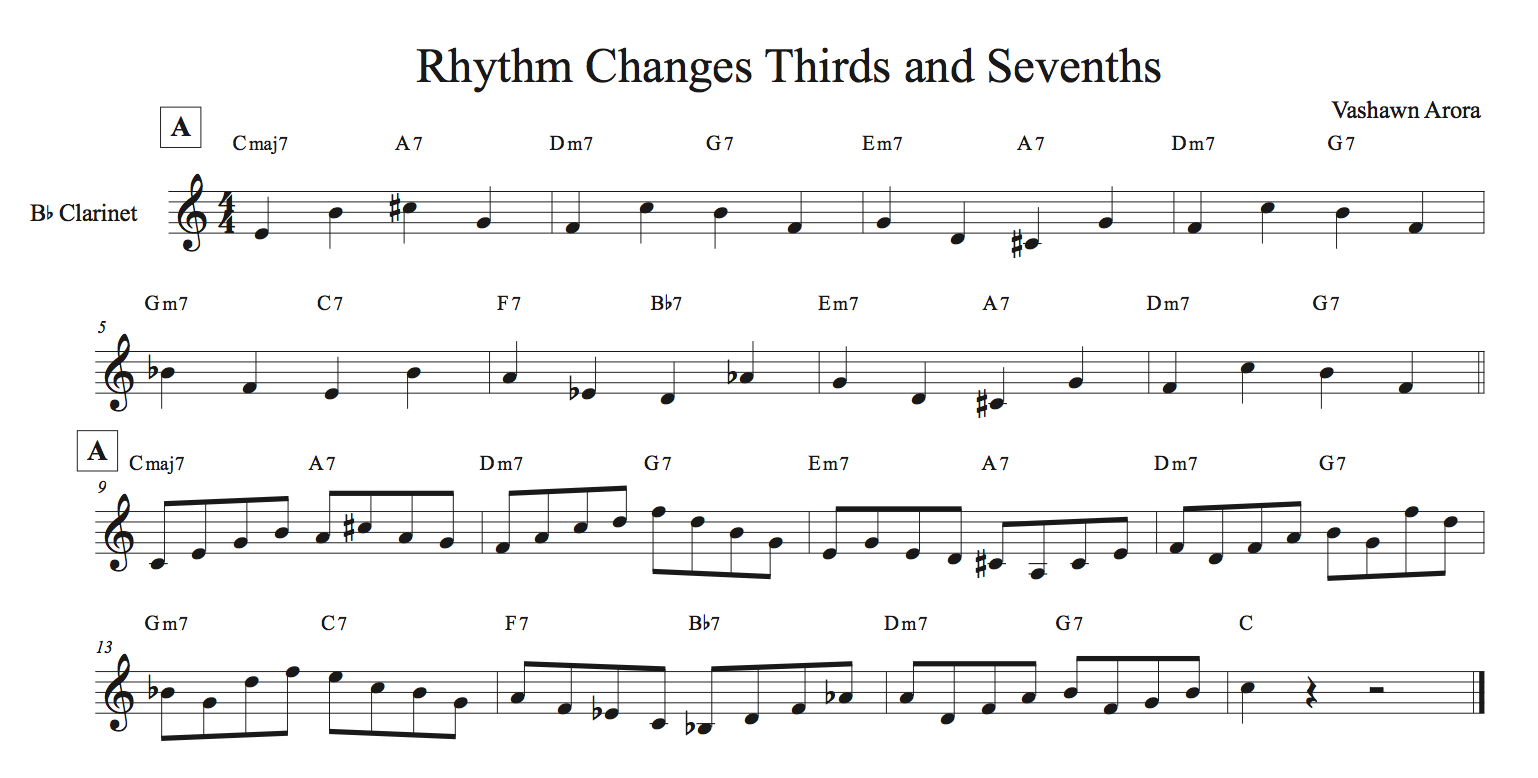
Transcription
First, keep listening over and making final edits to your “Six Appeal” transcription. On Day 8 we’ll check our work. In addition, let’s begin listening to our next transcription. Here is “Teclas Pretas” by Anat Cohen and Choro Aventuroso. This presents a great opportunity to look at some Afro-Cuban based jazz influences outside of the United States. Choro is a 1920s genre that originated in Brazil. Take a listen and enjoy this unusual instrumentation. We’ll start this on Day 9.
Day 8
Repertoire
Below is my transcription of “Six Appeal” by Benny Goodman and sextet. Check and see what differences we had. Remember, there is no singular correct way to interpret and notate. What decisions did you grapple with and why? How did you choose to notate articulation, dynamics, rhythmic durations, melodic embellishments, etc. After listening, notating, and writing out fragments of the tune at a time, you should feel more comfortable playing along.
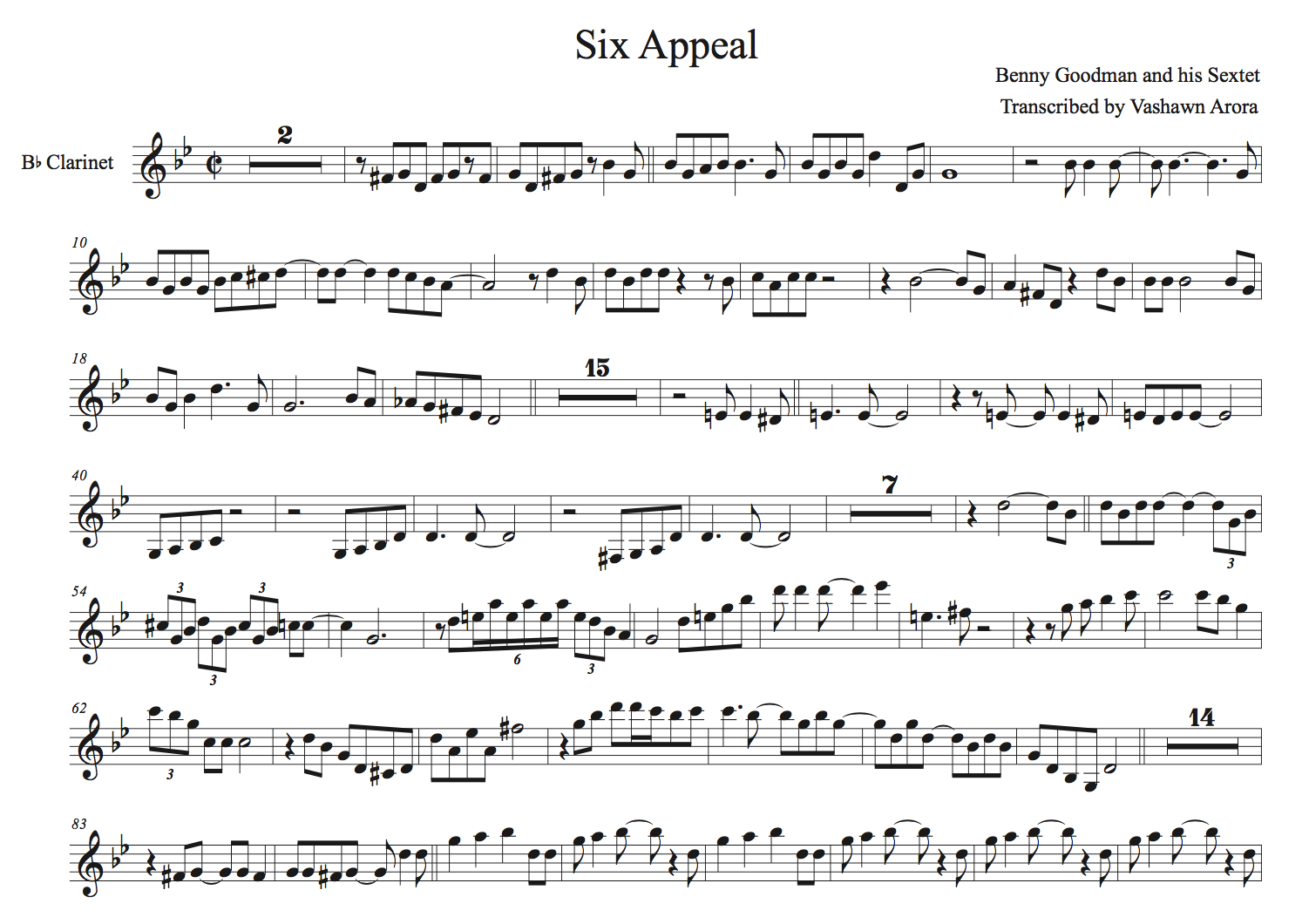
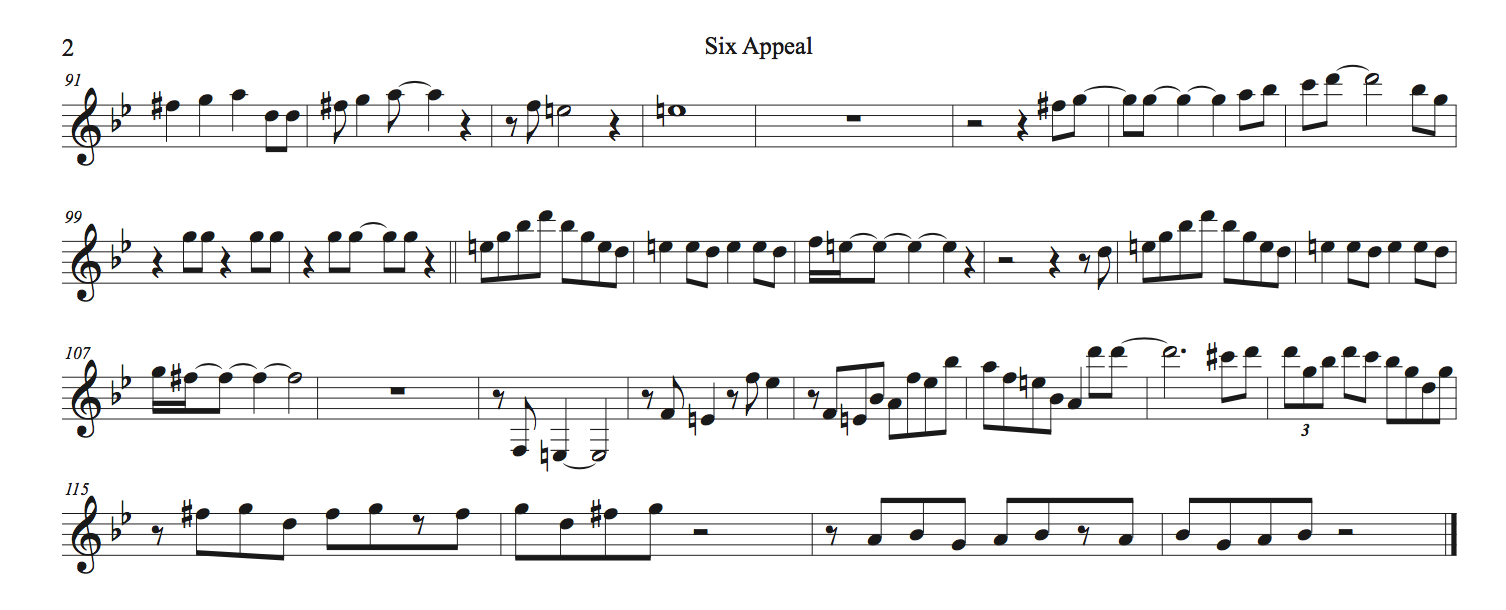
Day 9
Fundamentals
We can build off our initial exercise on Day 2 by expanding our triadic cells to diatonic sevenths. Adding this technique will make our thirds and sevenths connection feel more smooth and aid our music theory development with regard to analyzing and improvising over chord changes.
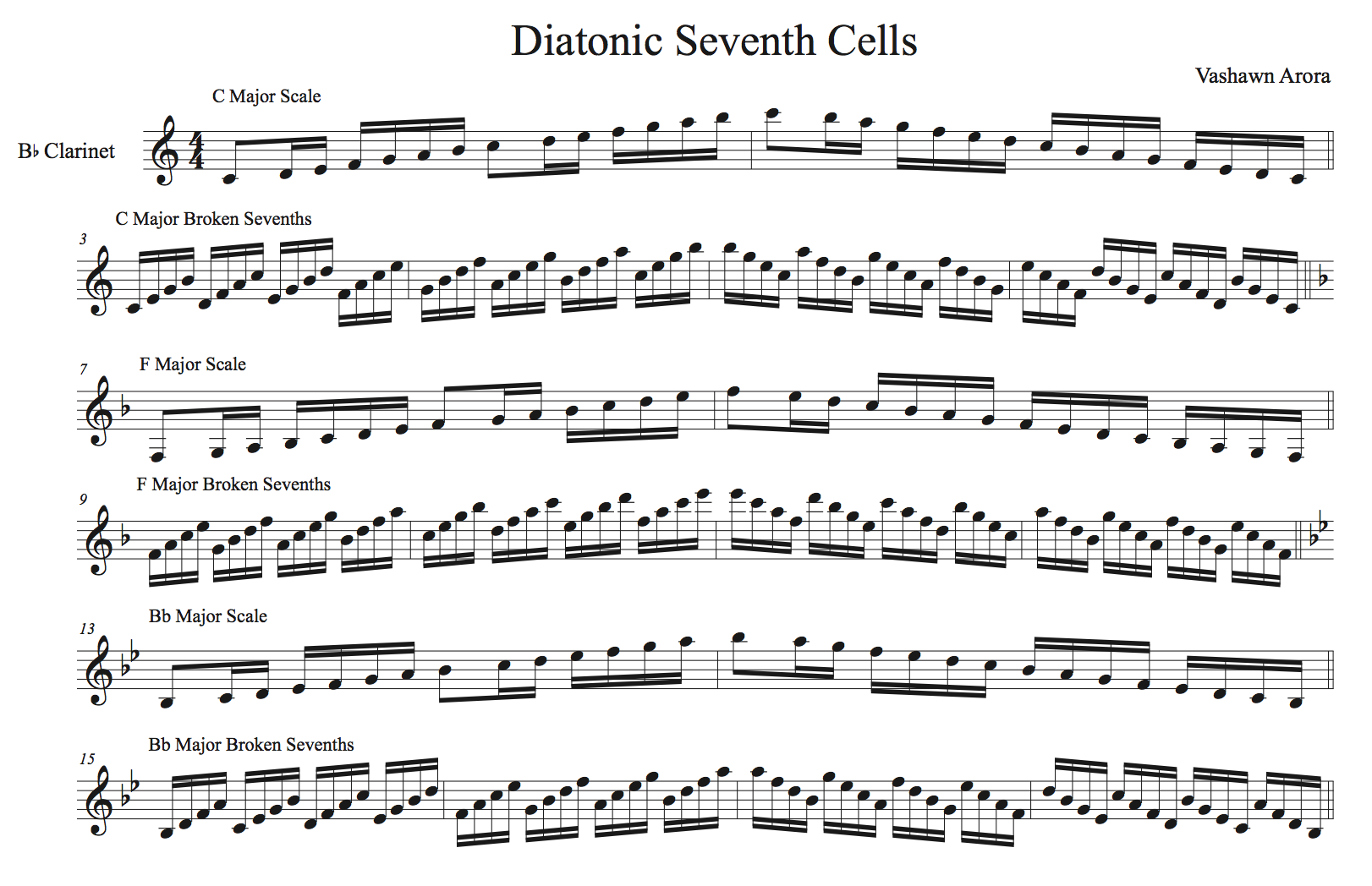
Transcription
Let’s begin “Teclas Pretas” by Anat Cohen and Choro Aventuroso. For this transcription, we are only transcribing the first A section of the tune. There are many scenarios where you will have to transcribe with finite time parameters. To adjust, let’s attempt this transcription at tempo with no speed alterations. Half note equals about 110. The piece begins with 8 bars of intro in cut time with the clarinet and accordion pickup. For today, let’s aim for the first 8 bars.
Day 10
Fundamentals
Moving away from diatonic cells derived from major keys, there are other permutations around diatonic jazz patterns that we can rotate around the circle of fifths. Below is a jazz pattern with the scale degrees written above each note. The next few keys in the circle of fifths are notated. See if you can work your way around to every major key and get back to C major.
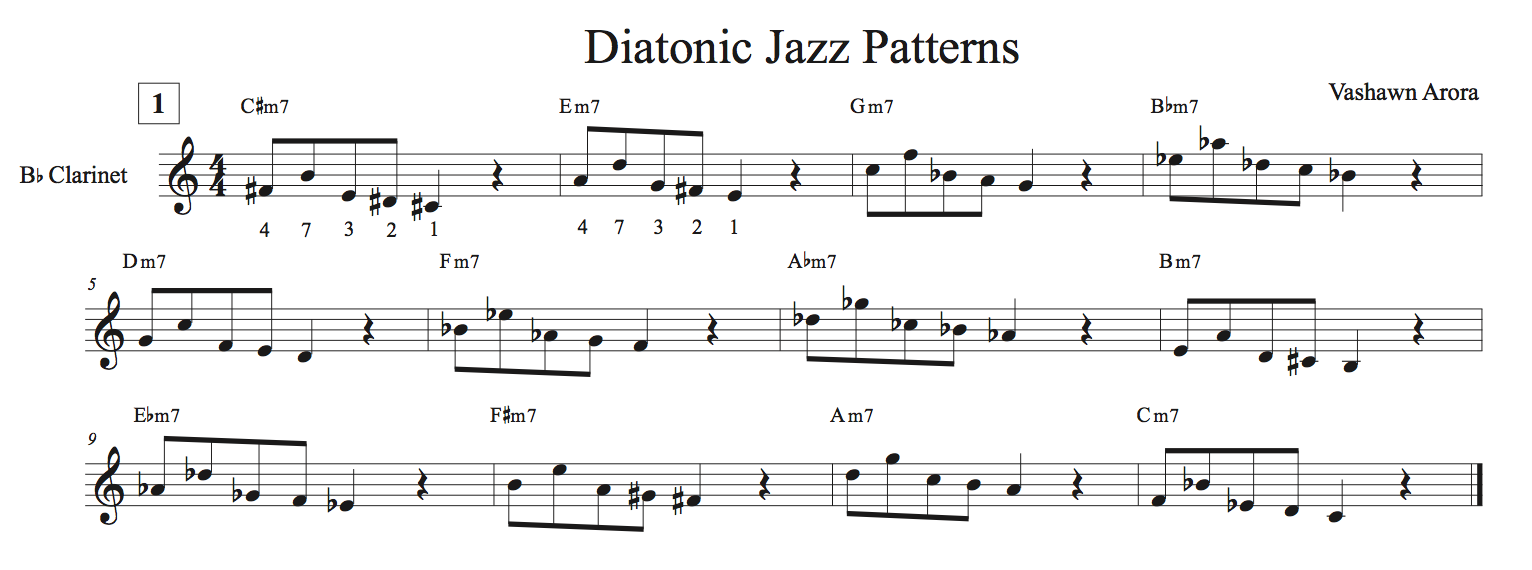
Transcription
Let’s finish up with the last 8 bars of “Teclas Pretas”. Though only sixteen bars, there are a great amount of decisions to unpack and grapple with.
Day 11
Repertoire
Here is my transcription of the initial A section of “Teclas Pretas”. Compare rhythmic values at the ends of phrases and enharmonics. Feel free to work this nice melodic line up on the clarinet. Our work from Day 9 on Major Broken Seventh Cells should help.
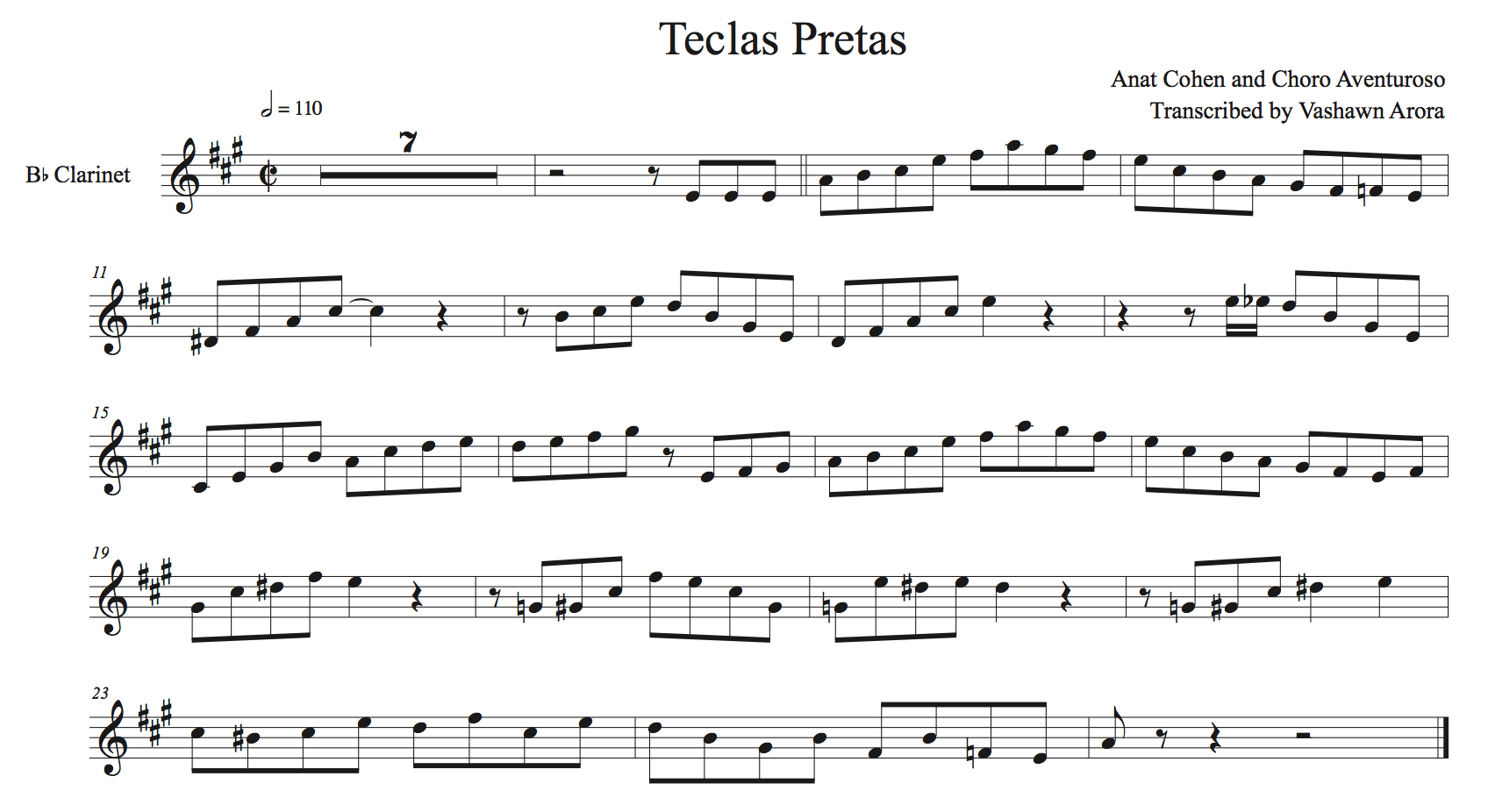
Transcription
For our final transcription, we are moving into bebop jazz literature originating in the 1950s. This subgenre saw drastic advancements in instrumentation and harmonic and melodic language from the previous swing era. Here is “Anthropology” by Chris Potter. Chris Potter is an American jazz saxophonist and composer. Anthropology is a common contrafact of rhythm changes from George Gershwin’s “I Got Rhythm”. Looking back to Day 7, we are already familiar with the A sections of this form. Take a listen and try look back at our work from Day 7 to pick out the entire 32 bar form.
Day 12
Fundamentals
Another set of diatonic jazz patterns. Like the last one, this one moves up by minor thirds. Each row moving up a half step til your back in the original key. Practice these at various tempos and with different sets of articulation.
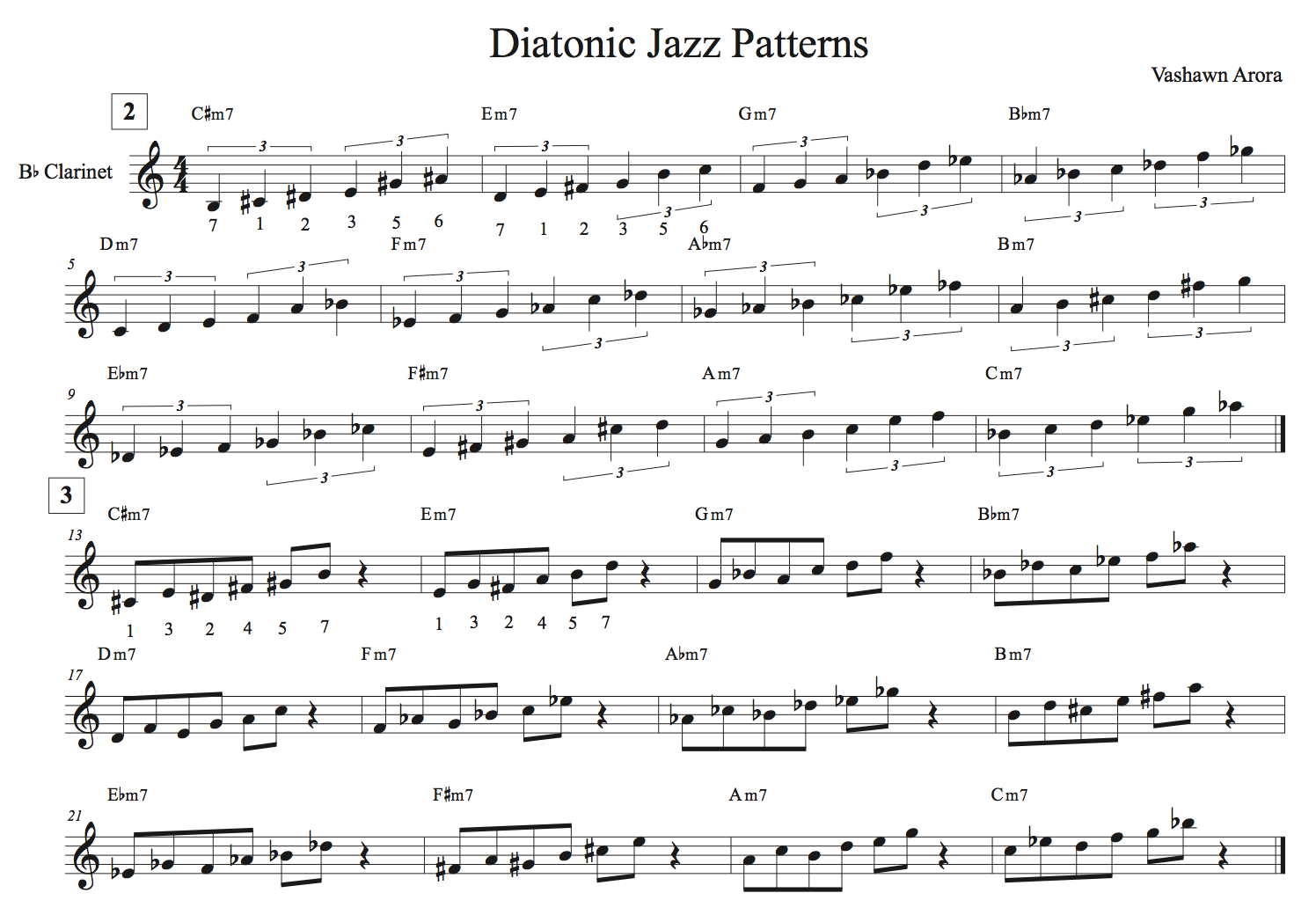
Transcription
First 32 bars of “Anthropology” is the “head” or the notated melody to play before the improvisation sections. Let’s work on getting the main melody transcribed today. You’ll notice that the smaller formal structures will be AABA within one chorus or the head, equaling 32 bars.
Day 13
Fundamentals
The exercise below shows a progression through different seventh arpeggios based off of the same tonic. Order: Maj 7th, Dom 7th, Min 7th, Half dim. 7th, Fully dim. 7th. This progression lowers one note each arpeggio, showing the necessary alterations to get from one seventh to the next. Likewise, you can take this exercise around the circle of fifths.
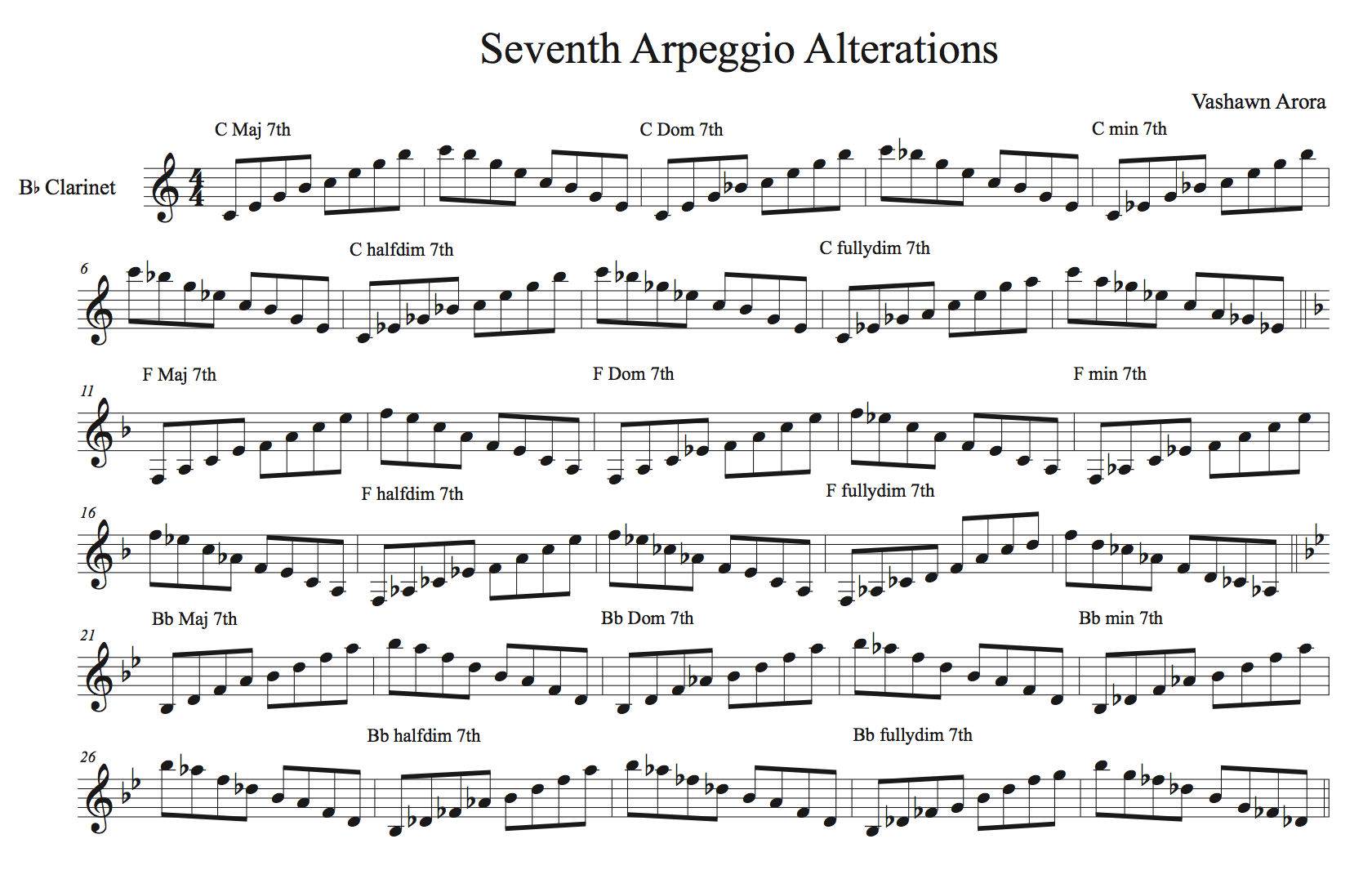
Transcription
After the head, Chris Potter takes his solo over the 32 bar form. Let’s focus on the one the first chorus of his solo, also 32 bars within the AABA structure. Take note of his syncopation and where exactly he starts and ends his phrases.
Day 14
Repertoire
Below is my transcription of Chris Potter’s “Anthropology”. While the tempo is very quick, feel free to use this slower backing track below to play the head and solo along (tempo change to around half tempo, quarter note equals 220 to 110). I’ve also included the second solo chorus so you can create more ideas for building your own solo over rhythm changes.
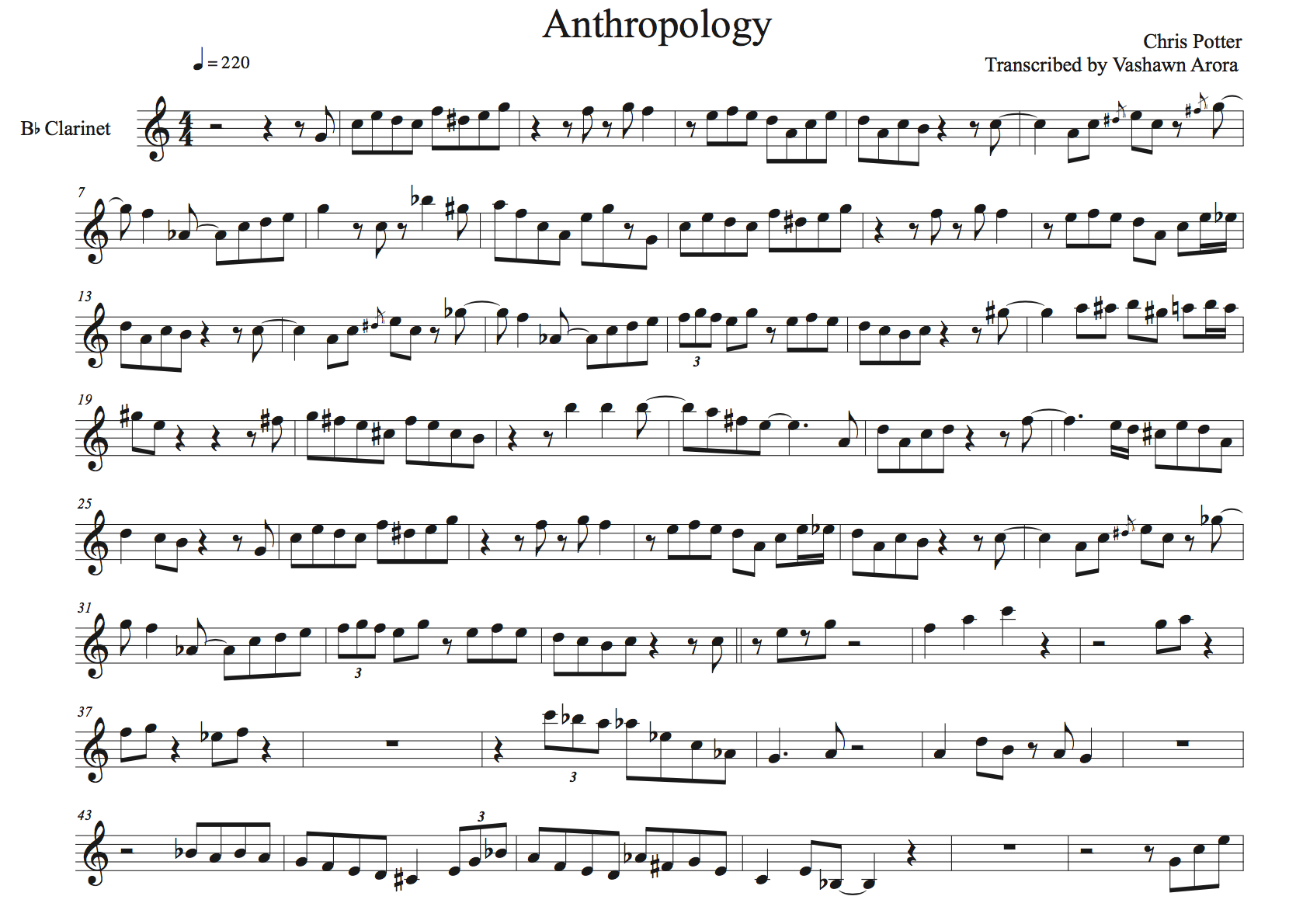
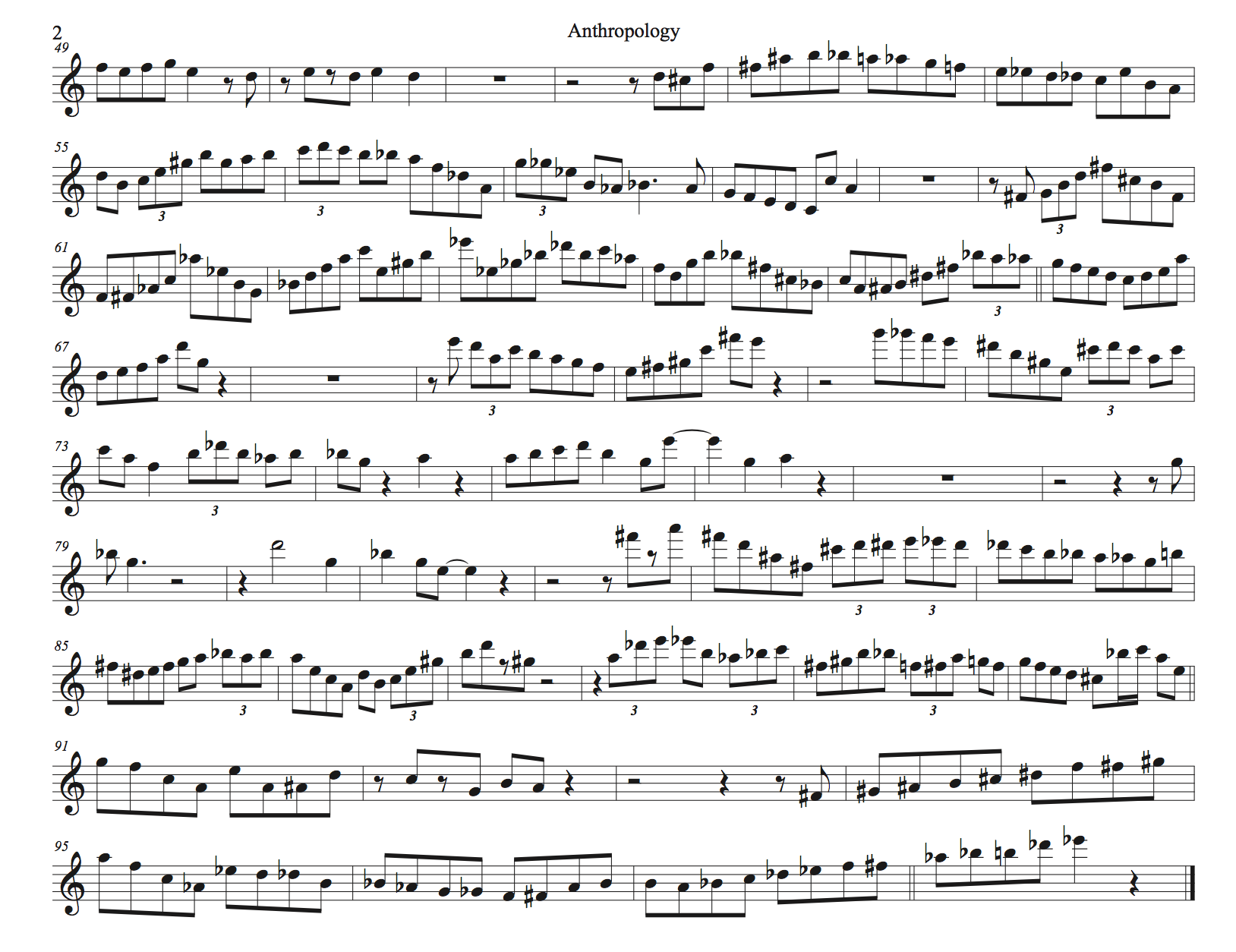
Conclusion
Currently, I am pursuing a double major in Clarinet Performance and Music Theory and
Composition at Arizona State University. This project is greatly relevant to my undergraduate
studies as having an extensive pedagogical approach to this genre is essential in assessing and
teaching different components of jazz clarinet studies. This visual and appealing aspect will
allow readers of my intended audience to easily understand, reproduce, and integrate the two
week routine in their own practice sessions. This mainly pertains to high school and collegiate
students looking to dive into the jazz clarinet repertoire world. In addition, other music
educators can visit this open source database to inform different decisions on how to approach
jazz clarinet methods and techniques.
This project was difficult in conveying and assessing a starting point regarding musical skill and
ability through a digital medium. Assumptions ranging from fundamental capabilities and
allotted daily commitment times all had to be inferred in crafting a daily routine that
encompasses a wide variety of students at different musical levels. Selecting repertoire and
appropriate discography was difficult considering the strict permaters. There are many valued
approaches regarding what repertoire to study, transcribe, and internalize. My goal was to create
a logical progression where each component was justified from previous days. For example, the
audio introduction to rhythm changes was initially used to complement improvisation with
realizing important chord tone movement. This also led to the final transcription of
“Anthropology”, a contrafact derived from rhythm changes.
Pieces used in this project
- Careless Love - written by W.C. Handy, performed by Dr. Michael White and Jazz at Lincoln Center
- Six Appeal - written by Benny Goodman, performed by Benny Goodman and his Sextet
- Teclas Pretas - written by Paschoal de Barros, performed by Anat Cohen at Choro Aventuroso
- Anthropology - written by Charlie Parker and Dizzy Gillespie, performed by Chris Potter
The composers and their respective publishing outlets used in this project retain full rights to these excerpts and the compositions themselves.